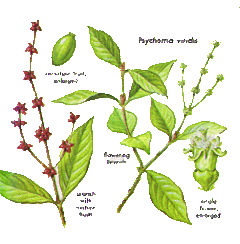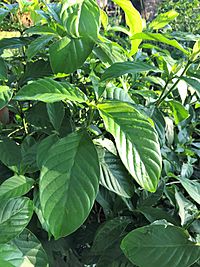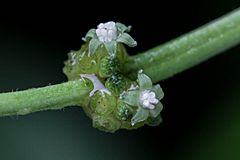Psychotria viridis facts for kids
Quick facts for kids Psychotria viridis |
|
|---|---|
 |
|
| Scientific classification | |
| Genus: |
Psychotria
|
| Species: |
viridis
|
| Synonyms | |
|
|
Psychotria viridis, also called chacruna, is a plant in the coffee family. It is a perennial plant, meaning it lives for more than two years. It grows as a shrub and has flowers.
This plant is a close relative of Psychotria carthagenensis, which is found in Ecuador. People in the Quechua languages also call Psychotria viridis chacrona or chaqruy.
Contents
Description
P. viridis is a shrub that can grow up to about 5 meters (16 feet) tall. Its branches can spread out to about 2 meters (6.5 feet) wide.
Stems
The stems of Psychotria viridis have special features. Between where two leaves grow opposite each other, there is a small horizontal line. This line is usually about 0.3 to 1 millimeter wide.
Along the top of this line, there is a fuzzy row of tiny plant hairs. These hairs are called trichomes. They are usually 0.5 to 1 millimeter long and look reddish-brown when dry. These features help scientists identify many plants in the Psychotria group.
Stipules
Stipules are like small, leafy parts that protect new leaves as they grow. They are found at the base of the leaf stalk. In P. viridis, stipules grow in pairs.
They are usually 5 to 25 millimeters long and 4 to 12 millimeters wide. They are shaped like an oval and have a sharp point at the end. Their edges often have a fringe, like tiny hairs.
Leaves
The leaves of Psychotria viridis grow in pairs, opposite each other on the stem. They are usually 5 to 15 centimeters (2 to 6 inches) long and 2 to 6 centimeters (1 to 2.5 inches) wide. They are often oval-shaped, sometimes wider at the top.
The leaves usually have a sharp point at both ends. They feel like paper and are mostly smooth. They have 5 to 10 pairs of side veins. On the underside of the leaves, you can often find small pockets called foveolae. The leaves grow on small stalks called petioles, which are usually 1 to 10 millimeters long.
Foveolae
Foveolae are tiny pockets found on the underside of the leaves. They are usually near where the side veins meet the main vein. These pockets act as shelters for very small creatures, like mites.
These mites often help the plant. They live in the foveolae and eat fungi or other small bugs that could harm the leaf. Foveolae are special to Psychotria viridis and some related plants. They are usually 1.5 to 5 millimeters long and 0.5 to 1 millimeter wide at the top. They are shaped like cones and open near a side vein.
The number and shape of foveolae can be different on various plants and even on different leaves of the same plant. Most leaves have at least one pair of foveolae.
Cultivation
Psychotria viridis grows best in warm climates. It can survive in USDA zone 10 or warmer.
It is easiest to grow this plant from cuttings. Even a single leaf, partly covered with soil, can grow into a new plant. Growing from fresh seeds also works well. However, older seeds that were not stored properly might not sprout easily. Even fresh seeds can take 2 to 6 months to sprout.
If grown indoors using hydroponics (growing plants in water without soil), the plant needs a light and dark cycle. The plant's roots do not use as much water during the day. The best pH level for the water is between 5.5 and 6.1. The amount of nutrients in the water should be between 300 and 500 parts per million (ppm). Too many nutrients can harm the plant.
Natural Compounds
Psychotria viridis contains certain natural compounds. These special chemicals are found in the dried plant.
Traditional Medicine
The Machiguenga people, who live in Peru, use the juice from the leaves of Psychotria viridis. They use it as eye drops to help treat migraine headaches.
Images for kids
See also
 In Spanish: Psychotria viridis para niños
In Spanish: Psychotria viridis para niños





